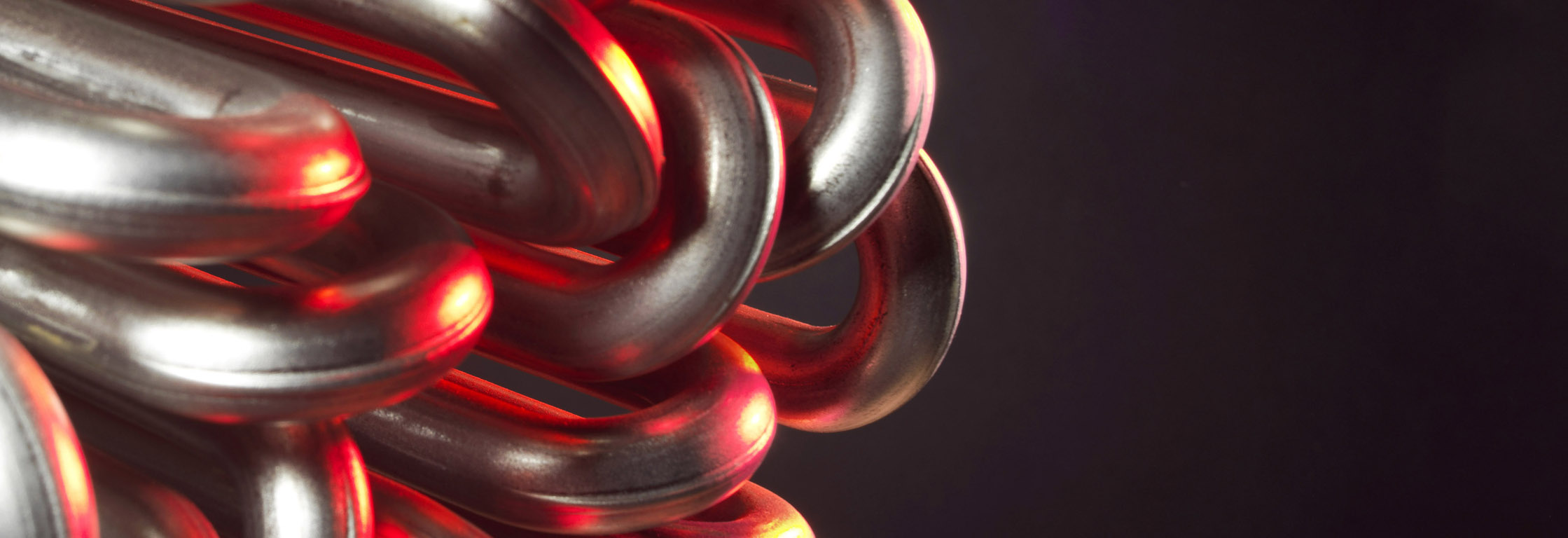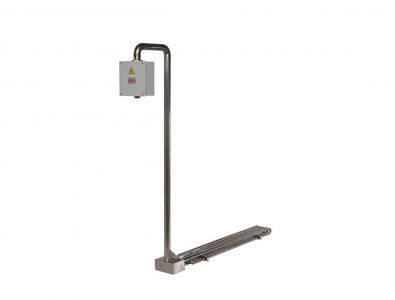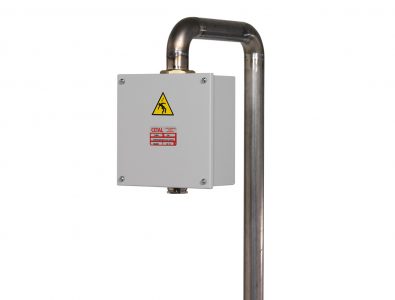
Movable immersion heaters
Product overview
- Power according to specification
- Voltage up to 690V
- Screw plug in steel, brass or stainless steel
- Dimension adapted to process equipment
Advantages
- Large range of materials and options according to customer process and application
- Benefit from CETAL’s 50 years of experience as designer and manufacturer!
- The end-to-end control of the design and production chain allows us to deliver a product which suits your process perfectly
Operating conditions
- Normal (non-ATEX)
- Hazardous areas (ATEX/IECEx) and NEC 505
- Extreme environments: – 60°C to + 80 °C
- Fluid/solid: from – 270 °C (3 K) to 1000 °C
- Onshore / Offshore environment
- Salt atmosphere
Water
- Stagnant water, max load 8 -12 W/cm², material: copper, 321, 316L
- Circulating water, max load 10 -16 W/cm², material: copper, 316L, inc 800, inc 825
- Boric water, max load 8 W/cm², material: 316L
- Boiler water, max load 8 -16W/cm², material: 316L, inc 800, inc 825
- Chlorated water, max load 6 W/cm², material: inc 825
- Sea water, max load 3,5 -6 W/cm², material: inc 825, inc600
- Demineralized water / deionized / distilled / Softened,max load 4 -6 W/cm², material: 316L, inc 800, inc 825
- Domestic hot water, max load 4 -8 W/cm², material: copper, 316L, inc 825
- Caustic water (2%, 10%, <30%, 70%), max load 2,3-7W/cm², material: 316L, inc 825, inc 600
Oil
- Fuel oil pre-heating, light fuel oil, C fuel oil, max load 1 – 2 W/cm², material: 321, 316L
- Heavy fuel, max load 0.5 – 3.5 W/cm² acc to grade, material: 316L
- Gasoline, kerosene, max load 3.0 – 3.5 W/cm², material: 316L
- Machine oil SAE 10, 30, 40 & 50, max load 2,0 – 3.5 W/cm², material: 316L
- Mineral oil , max load 0.5 – 3.5 W/cm² acc to temp, material: 321, 316L
- Lube oil, max load 2,3 W/cm², material: 321, 316L
Acid & corrosive fluid
- Acetic acid, max load 6W/cm², material: 316L, inc 825
- Boric acid, max load 6W/cm², material: inc 825
- Chloric, hydrofluoric, nitric, sulphuric acide, max load 1.5W/cm², material: teflon coat
- Boric acid, max load 6W/cm², material: inc 825
- Alkaline bath, max load 6W/cm², material: 321 (no corrosive compound), 316L
- Phosphate bath, max load 4W/cm², material: 316L, inc 825
Glycol
- Ethylene glycol, propylene glycol, 4 to 8 W/cm² acc. to concentration, material: 321, 316L
Others
- Asphalt, tar, and other heavy or highly viscous compounds, max load 0.5 – 1.5W/cm², material: 316L
- Milk, max load 0.3W/cm², material: 316L
Technical description
The watt density, tube diameter and the tube sheath are chosen to optimize the reliability and robustness (corrosion, temperature) of CETAL equipments.
Technologies
- Tubular heating element (most fo the cases)
- Heating rods into sleeve
Tube diameter & material
- Tube diameter: 6.5 / 8.5 / 10 / 13.5 / 16 mm
- Tube material:
- Stainless steel: AISI 321 (1.4541) / AISI 316L (1.4404) / AISI 309 (1.4828)
- Others: Incoloy 800 (1.4876) / Incoloy 825 (2.4858) / Inconel 600 (2.4816)
- Titanium
- Specific coating: Teflon™ (PTFE) / Halar
- Tube type: sealed tube
Manufacturing
- 100% of the components come from our high-quality suppliers from Europe
- 100% manufacturing in CETAL factory

- Connection terminals
- Tube
- Insulation : magnesia oxyde (Mg O), to secure optimized heat transfer and electrical insulation.
- Resistance wire: Made of Nickel Chrome 80/20, it is the active part of the heating element (Joule effect)
- Cold length
- Sealing material: Keeps out external moisture. Different types (silicon, resins, cement) are used depending on the industrialapplication, the external medium and temperature.
- Output insulation: Made of steatite ou corundum, it provides dielectric insulation (creepage distance, distance in the air).
- Heating elements welded to the fastening flange or to a sealed casing welded to the stainless steel rising bath.
- Enclosure away from the evaporation area
- Temperature sensors (thermostat, limiter, thermocouple or PT100) in the medium (process control) or on theheating element (safety control), on the flange or in the connecting box.
- Voltage: VAC or VCC
- Cabling according to main voltage VAC/VCC 1PH + N or 3PH
- Power : a few Watt to several Megawatts
Electrical tests
- Power test by cold resistance measurement. Allowed tolerance: -5% and +10% of the nominal resistance value.
- Insulationtest, direct voltage 500 V, mini cold value is > 100 Megohms
- Dielectric test, (2U + 1000 V) x 1,2 during 1 second
- The stray current and the hot dielectric rigidity can be measured on a sample at operating temperature (on request).
- 100% of the heating elements are tested before shipment (Final control)
Mechanical tests
- Visual inspection
- X-ray test (if required)
- Liquid penetrant test
- Pressure control test
Dimensional test
- Critical dimension are tested


